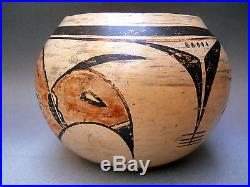
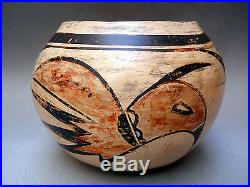
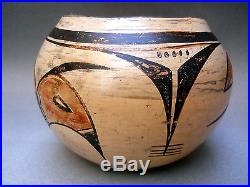
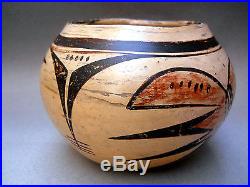
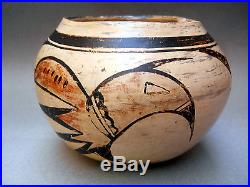
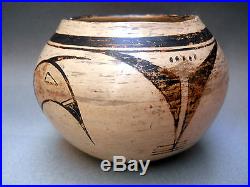
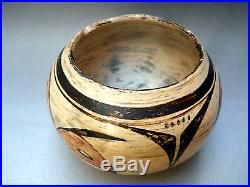
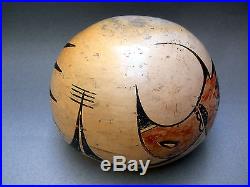
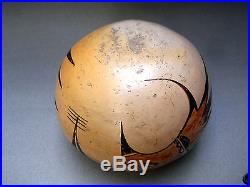
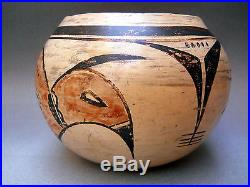
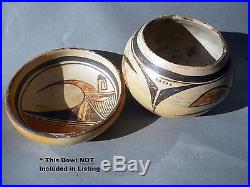
RARE BIRD MOTIF w/ WHITE KAOLIN. Easily Attributed to Nampeyo of Hano. “Circa 1901 -1905, Pre-Hopi House Era”. Wide & 3-1/2 in. The Sikyatki inspired twin “Man-Eagle” birds. The bowl is more. White-like in the daylight than what the photos display. Note the new last photo with sunlight – with another bowl (NOT included in this Listing). It may help to illustrate the aged color, and provide comparison of the antique color tone of. The black and “splotchy” red finishes, as well as the main body color. Note a minor chip on rim of Bird bowl & age related abrasion. Again, the 2nd bowl is NOT included in this listing. There is no question who made that one. Our ” Attribution Process ” is much more than an ” aesthetic appraisal ” based on our extensive experience, in as much as we methodically analyze every factor – all the design elements & layout, paint tone, ceramic production excellence, and various combinations of each togethe r etc. To determine with linear logic the mathematical probabilities that the piece in question could only have been made by one artist, and one artist alone. Design motif that separates the birds, were one of Nampeyo’s unique signature motifs. Note the asymmetrical accent of five dots, the perfect form of the bowl, polished exterior, and the decisively executed painting of the rare bird motif. This Nampeyo bowl is slipped with a non-crazing white kaolin slip as opposed to the typical crazing seen in the slip of Polacca wares. During the first decade of the 20th century, Kaolin slip was obtained from the Coyote Springs area. Coyote Springs was by the Nampeyo family ranch and supplied the finest kaolin clay in the area. Apparently, the kaolin deposit at Coyote Springs became exhausted during the first decade of the 20th century. Decades after Nampeyo’s use of the white slip, Paqua Naha ” rediscovered ” the use of a burnished kaolin slip still currently in use by her descendants Very few such Bird bowls of Nampeyo can be found today anywhere – even in Museum collections. Both the exact shape, specific design elements. As well as the. With other pottery bowls from the antiquities market. Generally accepted as attributed to Nampeyo of Hano. “When I first began to paint, “. Nampeyo told Ruth Bunzel. Through an interpreter in the 1920s. I used to go to the ancient villages. And copy the designs. That is how I learned to paint. But now I just close my eyes. And I paint them. Museum Grade – without any major cracks. Don’t be misled by such practices. DOUBLE BOXED, and FULLY INSURED. We don’t gamble with Nampeyo Pottery. We reserve the right to waive it at our discretion. The free listing tool. The item “NAMPEYO of Hano! REDUCED! Ultra-RARE Vintage Hopi BIRD BOWL with WHITE Slip! SALE” is in sale since Sunday, November 20, 2016. This item is in the category “Collectibles\Cultures & Ethnicities\Native American\ US\1800-1934\Pottery”. The seller is “this_olde_house” and is located in Quincy, Illinois. This item can be shipped to North, South, or Latin America, all countries in Europe, Japan, Australia.
- Provenance: Ownership History Not Available
- Artisan: attributed to Nampeyo of Hano
- Origin: First Mesa – Hopi Res.
- Tribal Affiliation: Hopi Tewa
- Country/Region of Manufacture: United States